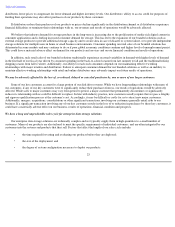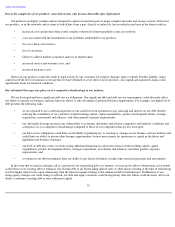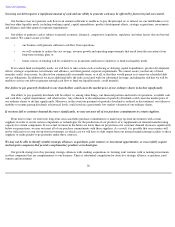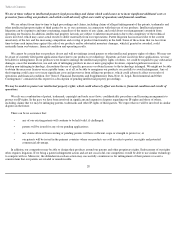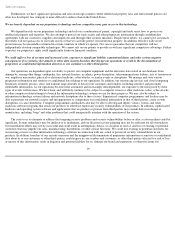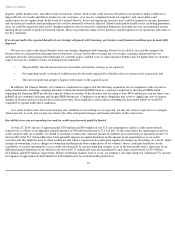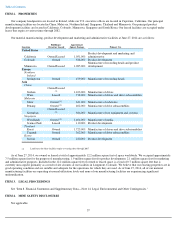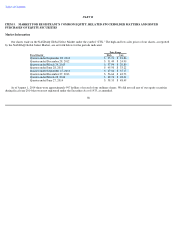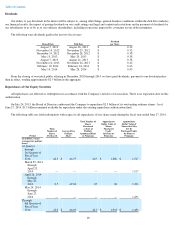Seagate 2013 Annual Report Download - page 34
Download and view the complete annual report
Please find page 34 of the 2013 Seagate annual report below. You can navigate through the pages in the report by either clicking on the pages listed below, or by using the keyword search tool below to find specific information within the annual report.
Table of Contents
possibility that the financial condition of particular customers may worsen during the course of the payment period.
• Seasonality. Seasonal reductions in the business activities of our customers during the summer months, particularly in Europe,
typically result in lower earnings during those periods.
• Legal and Regulatory Limitations. Our international operations are affected by limitations on imports, tariffs, duties, currency
exchange control regulations, price controls, export control laws, including the trade and economic sanctions administered by the
Office of Foreign Assets Control, and other restraints on trade. In addition, the governments of many countries, including China,
Malaysia, Northern Ireland, Singapore and Thailand, in which we have significant operating assets, have exercised and continue
to exercise significant influence over many aspects of their domestic economies and international trade. Although we have
implemented policies and procedures designed to ensure compliance, there can be no assurance that our employees, contractors,
or agents will not violate these or other applicable laws and regulations to which we may be subject. Violations of these laws and
regulations could lead to significant penalties, including restraints on our export or import privileges, monetary fines, criminal
proceedings and regulatory or other actions that could materially adversely affect our results of operations.
• Potential Adverse Tax Consequences. Our international operations create a risk of potential adverse tax consequences, including
imposition of withholding or other taxes on payments by our subsidiaries. In addition, our taxable income in any jurisdiction is
dependent upon acceptance of our operational practices and intercompany transfer pricing by local tax authorities as being on an
arm's length basis. Due to inconsistencies in application of the arm's length standard among taxing authorities, as well as a lack of
adequate treaty-based protection, transfer pricing challenges by tax authorities could, if successful, substantially increase our
income tax expense. We are subject to tax audits around the world, and are under audit in various jurisdictions, and such
jurisdictions may assess additional income tax against us. Although we believe our tax positions are reasonable, the final
determination of tax audits could be materially different from our recorded income tax provisions and accruals. The ultimate
results of an audit could have a material adverse effect on our operating results or cash flows in the period or periods for which
that determination is made and could result in increases to our overall tax expense in subsequent periods.
• Increased Costs. The shipping and transportation costs associated with our international operations are typically higher than
those associated with our U.S. operations, resulting in decreased operating margins in some foreign countries.
• Credit and Access to Capital Risks. Our international customers could have reduced access to working capital due to higher
interest rates, reduced bank lending resulting from contractions in the money supply or the deterioration in the customer's or its
bank's financial condition, or the inability to access other financing.
• Global Health Outbreaks. The occurrence of a pandemic disease may adversely impact our operations, and some of our key
customers. Such diseases could also potentially disrupt the timeliness and reliability of the distribution network we rely on.
• Access to Personnel. There is substantial competition for qualified and capable personnel in certain jurisdictions in which we
operate, including China, which may make it difficult for us to recruit and retain qualified employees in sufficient numbers.
Increased difficulty in recruiting or retaining sufficient and adequate personnel in our international operations may lead to
increased manufacturing and employment compensation costs, which could adversely affect our results of operations.
31




